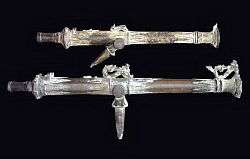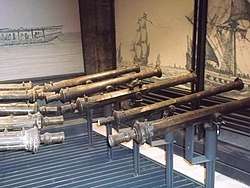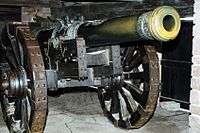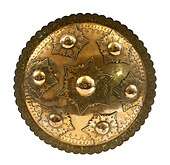Lantaka
Lantaka or rentaka was a type of bronze portable cannon or swivel gun, sometimes mounted on merchant vessels and warships in Maritime Southeast Asia.[1] It was commonly equipped by native seafaring vessels from the Philippines, Indonesia, Brunei, and Malaysia.[2] Rentaka and lela is known by the Malays as meriam kecil (lit. "small cannon"),[3][4] the difference is that rentaka is smaller in length and bore than a lela.[5]

The lantaka was cited by the National Commission for Culture and the Arts of the Philippines as an intangible cultural heritage of the country under the 'Traditional Craftsmanship' category that the government may nominate in the UNESCO Intangible Cultural Heritage Lists. The documentation of the craft was aided by ICHCAP of UNESCO.[6]
Etymology
The name may stem from the Malay word lantak, which means "hammering down" or "ramming down",[7] referencing its loading process (muzzle-loading). Ramrod in Malay is called pelantak.[8] The malay word rentak means "stamping the feet in anger",[8] "pounding the feet together".[9]
Description
.jpg)
Lantaka is the "younger sibling" of lela, they are smaller, with length of less than 100 cm.[5] Typically, bore diameters of these cannons were in the range of about 10-50 mm.[3] Many of these guns were mounted on swivels (called cagak in Malay)[3] and were known as swivel guns. The smaller ones could be mounted almost anywhere including in the rigging. Medium-sized cannons were frequently used in reinforced sockets on the vessel's rails and were sometimes referred to as rail guns. The heaviest swivel guns were mounted on modified gun carriages to make them more portable.
Typically the earliest cannon with beautiful ornaments from this region are from foundries in Melaka and Pahang,[10] with later models from foundries in the Netherlands and Portugal, next from their respective settlements, and finally from Brunei and other local craftsmen. However, there were also double-barreled variants that were used extensively in the Philippines. In Malaysia, these double-barreled variants are called Meriam Lela (Malay for 'Lela Cannon') and appears to be longer than a typical lantaka.
History
The origin of gunpowder-based weaponry in Nusantara archipelago can be traced from the late 13th century. The Mongol invasion of Java brought gunpowder technology to java in the form of a cannon (Chinese: Pao).[11] This resulted in the development of Javanese breech-loading swivel gun, the cetbang. By the 1300s, the Majapahit fleet had already started using them as a naval weapon.[12][13] The Javanese mastered the art of bronze-smithing and use of a central arsenal fed by a large number of cottage industries within the immediate region. Documentary and archeological evidence indicate that Arab traders introduced gunpowder, gonnes, muskets, blunderbusses, and cannons to the Javanese, Acehnese, and Batak via long established commercial trade routes around the early to mid 14th century.[14]
Following the decline of the Majapahit, particularly after the paregreg civil war (1404-1406),[15]:174–175 the consequent decline in demand for gunpowder weapons caused many weapon makers and bronze-smiths to move to Brunei, Sumatra, Malaysia and the Philippines led to widespread use, especially in the Makassar Strait. This event led to near universal use of the swivel-gun and cannons in the Nusantara archipelago.[16] When the Portuguese first came to Malacca, they found a large colony of Javanese merchants under their own headmen; the Javanese were manufacturing their own cannon, which then, and for long after, were as necessary to merchant ships as sails.[17]
Most lantakas were made of bronze and the earliest ones were breech-loaded.[12] Michael Charney (2004) pointed out that early Malay swivel guns were breech-loaded.[18]:50 This indicated that the cetbang is the direct predecessor of the lantaka. There is a trend toward muzzle-loading weapons during colonial times.[19] Nevertheless, when Malacca fell to the Portuguese in 1511 A.D., both breech-loading and muzzle-loading swivel guns were found and captured by the Portuguese.[18]:50
The local population was unimpressed with the might and power of the heavily armed trading vessels of Portugal and Spain. De Barros mentions that with the fall of Malacca (1511), Albuquerque captured 3,000 out of 8,000 artillery. Among those, 2,000 were made from brass and the rest from iron, in the style of Portuguese Berço (breech-loading swivel gun). All of the artillery had its proper complement of carriages which could not be rivalled even by Portugal.[20][21][22]:62–64 The cannons found were of various types: esmeril (1/4 to 1/2 pounder swivel gun,[23] probably refers to cetbang or lantaka), falconet (cast bronze swivel gun larger than the esmeril, 1 to 2 pounder,[23] probably refers to lela), medium saker (long cannon or culverin between a six and a ten pounder, probably refers to meriam),[24] and bombard (short, fat, and heavy cannon).[18]:46 The Malays also has 1 beautiful large cannon sent by the king of Calicut.[18]:47[25]:22 The large number of artillery in Malacca come from various sources in the Nusantara archipelago: Pahang, Java, Brunei, Minangkabau, and Aceh.[10][26][27]
The Dutch and Portuguese quickly learned that they could trade cannons not only for spices and porcelain, but also for safe passage through pirate-infested waters. Local foundries continued to produce guns, using local patterns and designs from local brass and bronze objects. Stylized crocodiles, dolphins, birds and dragons were common motifs.
Local reaction

If a native vessel was unarmed, it was usually regarded by the local populace as improperly equipped and poorly decorated. Whether farmers, fishermen or headhunters, the villagers who lived in the longhouses along Borneo's rivers lived in fear of being taken by pirates who used both vessel-mounted and hand-held cannons. Villages and tribesmen that were armed with mounted or handheld cannon had a distinct advantage over those who could only rely on bows and arrows, spears, blowguns and krises (swords).
Land transportation in the 17th and 18th century Java and Borneo was extremely difficult and cannons were fired for virtually all types of signaling. Whether they were fired in celebration of a birth or wedding, or to warn another hilltop fortress or riverbank fishing village of impending attack, cannons were used to transmit messages telling of urgent or special events. Such events ranged from yellow fever and cholera epidemics to the start or finish of religious holidays such as Ramadan.
Distinguished visitors were ushered into longhouses with great ceremony, accompanied by the firing of the longhouse's cannon, much like today's twenty-one gun salute. These cannons were a display of the status and wealth of the extended family that controlled the longhouse.
All worked copper, brass and bronze had value and were used as trade items in early Borneo. Cannons were frequently part of the bride price demanded by the family of an exceptionally desirable bride or the dowry paid to the groom.
Many of the small cannons, often called personal cannons or hand cannons, had been received as honors and were kept and passed down in families, but in hard times they also served as a form of currency that could keep the family fed. As a recognized form of currency, cannons could be traded for rice, drums, canoes, tools, weapons, livestock, debts of honor, and even settlement of penalties for crimes ranging from the accidental death of a fellow villager to headhunting against another tribe.
Large cannons had the extra value of being used in both celebratory times and in warfare. The larger and/or more elaborate the cannon, the greater the trade value, and thus the greater the status of the owner.
Many of the finest cannons were given out by the Sultans of Brunei as part of ceremonies (such as birthdays or weddings) of the many princes and princesses of the extended Royal family. Cannons were frequently presented to guests along with awards and titles, and were meant to guarantee the recipients allegiance to the Sultan. Mortars, cannon and signal guns of all sizes were typically fired with colorful pyrotechnics on these occasions; the louder and more elaborate, the greater the honor.
Panday Piray of Pampanga, Philippines was also known for forging heavy bronze lantaka to be mounted on Lakan's (Naval Chief/Commander) ships called 'caracoas' doing battle against the Spanish invaders and cannons were also commissioned by Rajah Sulayman for the fortification of Maynila.
Modern era
_from_the_Sulu_Archipelago%2C_brass%2C_Honolulu_Museum_of_Art.jpg)
.jpg)
In the 1840s, England began suppressing headhunting and piracy and Rajah James Brooke (a wealthy Englishman who established the dynasty that ruled Sarawak from 1841 until 1946) distributed numerous Brunei-cast hand cannons to guarantee the cooperation and allegiance of the local chiefs. Lantaka were used by Moro soldiers in the Moro Rebellion against U.S. troops in the Philippines.[28] They were also used by the Filipinos during the Philippine Revolution, this time copied from European models and cast from church bells. One cannon founder was a Chinese Filipino named Jose Ignacio Pawa, a blacksmith also.
Today these guns can be found on virtually all of the islands of the Pacific Rim, but they are most commonly found in the Muslim areas of Indonesia and Malaysia. The largest collection is in Brunei, where it is now illegal to export them. Even in other countries, a museum export permit is usually required.
These cannons are now highly sought after by collectors, with some of the realized prices exceeding $50,000 USD for a single gun. The more common guns can be bought for under $1,000. Replicas and forgeries of lantaka are known to exist in considerable numbers.[29]
Today, most of the Christians in Mindanao and the rest of the Philippines refer the word "lantaka" to bamboo cannons (a noisemaker) or any improvised home-made noisemakers of the same firing mechanism usually made of bamboo tubes (Pula in Meranau or "Lapu"), segmented cans of condensed milk, or PVC pipes. They are usually used during New Year's Day celebrations as noisemakers, or often in medium-scale gang wars. Firing mechanism is the same as of the original lantaka, with denatured alcohol or calcium carbide mixed with water as its "gunpowder" (fuel) and a small lighted torch or lighter as the igniter.
See also
- Cetbang, earlier, 14th century cannon used by Indonesian kingdoms.
- Lela, a type of cannon similar but larger than lantaka.
- Luthang, a bamboo toy gun from the Philippines that originally referred to small lantaka.
- Miniature meriam kecil, a tiny version of meriam kecil (lela and lantaka), used mainly as a currency.
- Bedil (term), local term for gunpowder-based weapons.
References
- FILIPINO BLADE CULTURE AND THE ADVENT OF FIREARMS
- "Borneo Brass Cannon (Lantaka)". michaelbackmanltd.com. Retrieved 12 February 2020.
- "Cannons of the Malay Archipelago". www.acant.org.au. Retrieved 2020-01-25.
- Teoh, Alex Eng Kean (2005). The Might of the Miniature Cannon A treasure of Borneo and the Malay Archipelago. Asean Heritage.
- Ismail, Norain B.T. (2012). Peperangan dalam Historiografi Johor: Kajian Terhadap Tuhfat Al-Nafis. Kuala Lumpur: Akademi Pengajian Islam Universiti Malaya.
- "ICHCAP | e-Knowledge Center". www.ichcap.org. Retrieved 15 January 2020.
- Wilkinson, Richard James (1908). An Abridged Malay-English Dictionary (Romanised). Kuala Lumpur: F.M.S Government Press.
- Wilkinson, Richard James (1901). A Malay-English dictionary. Hongkong: Kelly & Walsh, limited.

- Departemen Pendidikan Nasional (2008). Kamus Besar Bahasa Indonesia Pusat Bahasa Edisi Keempat. Jakarta: PT Gramedia Pustaka Utama.
- A History of Greek Fire and Gunpowder. Retrieved 12 December 2014.
- Song Lian. History of Yuan.
- Ooi, Keat Gin (2004). Southeast Asia: A Historical Encyclopedia, from Angkor Wat to East Timor. ABC-CLIO. ISBN 9781576077702.
- Reid, Anthony (2012). Anthony Reid and The Study of Southeast Asian Past. Singapore: Institute of Southeast Asian Studies. ISBN 978-9814311960.
- Dipanegara, P.B.R. Carey, Babad Dipanagara: an account of the outbreak of the Java war, 1825–30 : the Surakarta court version of the Babad Dipanagara with translations into English and Indonesian volume 9: Council of the M.B.R.A.S. by Art Printing Works: 1981.
- Hidayat, Mansur (2013). Arya Wiraraja dan Lamajang Tigang Juru: Menafsir Ulang Sejarah Majapahit Timur. Denpasar: Pustaka Larasan.
- Raffles, Thomas Stamford (1978). The History of Java ([Repr.]. ed.). Kuala Lumpur: Oxford University Press. ISBN 978-0-19-580347-1.
- Furnivall, J.S (2010). Netherlands India: A Study of Plural Economy. Cambridge University Press. p. 9
- Charney, Michael (2004). Southeast Asian Warfare, 1300-1900. BRILL. ISBN 9789047406921.
- Hamid, Rahimah A. (2015). Kearifan Tempatan: Pandainya Melayu Dalam Karya Sastera. Penerbit USM. ISBN 9789838619332.
- A History of Greek Fire and Gunpowder. Retrieved 12 December 2014.
- A Descriptive Dictionary of the Indian Islands & Adjacent Countries. Retrieved 12 December 2014.
- Albuquerque, Afonso de (1875). The Commentaries of the Great Afonso Dalboquerque, Second Viceroy of India, translated from the Portuguese edition of 1774. London: The Hakluyt society.
- Manucy, Albert C. (1949). Artillery Through the Ages: A Short Illustrated History of the Cannon, Emphasizing Types Used in America. U.S. Department of the Interior Washington. p. 34.
- Lettera di Giovanni Da Empoli, with introduction and notes by A. Bausani, Rome, 1970, page 138.
- Crawfurd, John (1856). A Descriptive Dictionary of the Indian Islands and Adjacent Countries. Bradbury and Evans.
- Ismail, Norain B.T. (2012). Peperangan dalam Historiografi Johor: Kajian Terhadap Tuhfat Al-Nafis. Kuala Lumpur: Akademi Pengajian Islam Universiti Malaya.
- Ayob, Yusman (1995). Senjata dan Alat Tradisional. Selangor: Penerbit Prisma Sdn Bhd.
- Gaysowski, Richard (2000). "Lantaka' Is One Of Several Names For Small Hand-Carried Rail Guns". The Artilleryman. 22 (2). Retrieved 2009-07-05.
- "used cannon for sale". Archived from the original on February 7, 2009. Retrieved 2009-07-05.
External links
- The Sea Research Society has a collection of over sixty of these guns, most dating from the 17th and 18th centuries.
- The Temple of Proportions, an online cultural center, has three more pictures of a gorgeous Lantaka.



